#giulio zeppieri
Text
RG MS Q3: Meet Your Qualifiers (Day 1)
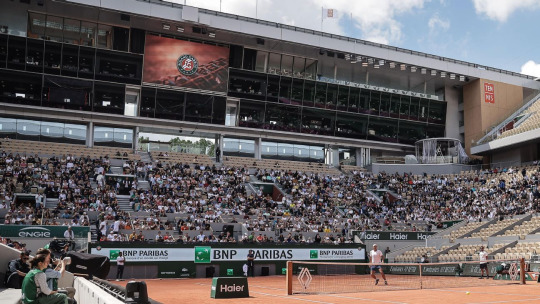
Illustration of Roland Garros qualifying rounds (📸 Archysport)
For a more compact version in the form of a Twitter thread, click here.
As per tradition in the French Open, differing from other Grand Slams, the third qualifying round matches are divided into two days, with one of the reasons likely being weather, as it turned out to rain upon the conclusion of the matches. Interestingly, due to the previous rain delays that happened yesterday, the 8 sections that finished first (3, 9-15) played today to find out the first 8 qualifiers to the Men's Singles sector in Roland Garros.
Recognizing that these qualifiers could often shock you (and your favorite players) in a way you will never imagine, meet your qualifiers (first part, also with the oversimplified match report):
Section 13: Shintaro Mochizuki def. Facundo Bagnis [13] 6-4, 2-0 ret.
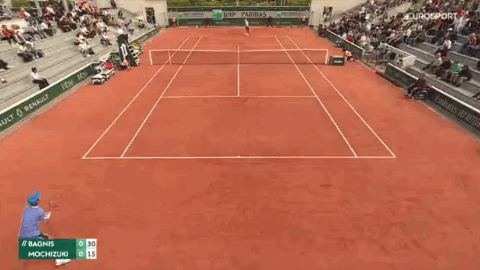
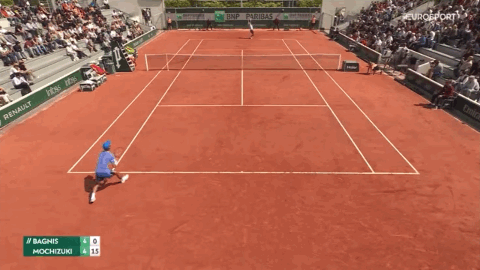
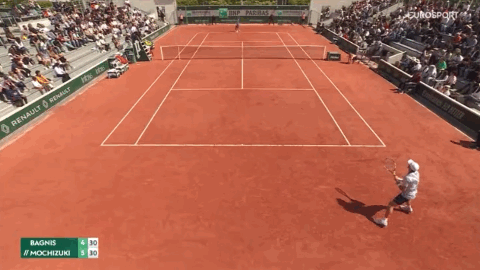
Shintaro Mochizuki's points to *0-0 30-30, 1st set (top left), to *4-4 0-30, 1st set (top right), and to set up his set point at *5-4 40-30, 1st set (bottom) (📸 Eurosport GB)
F. Bagnis came to the Roland Garros qualifying rounds thanks to shining through the Golden Swing, becoming the runner-up of Cordoba (250) to Luciano Darderi 1-6, 4-6, preceded by winning the Buenos Aires 2 (Argentino) Challenger against Mariano Navone in a comeback fashion 7-5, 1-6, 7-5 right before L. Darderi and M. Navone broke out. Trying to follow their journey in terms of resurgence, F. Bagnis continued with a runner-up showing in Santiago Challenger (l. Juan Pablo Varillas) and the quarterfinals in Aix-en-Provence Challenger albeit being unable to catch a break as he was forced to retire down 0-6 to eventual champion Alejandro Tabilo, coming to the Roland Garros third qualifying round without dropping a set as he defeated M. Tomas Barrios Vera and Juan Manuel Cerundolo both in straight sets (6-3, 6-2 and 6-4, 6-2, respectively). On the other hand, other than the competitive showing in the second round of Cagliari Challenger (l. Mariano Navone), S. Mochizuki might have shocked the most on paper as he stunned clay frequents Nick Hardt 4-6, 6-4, 6-2 and 18th seed Stefano Napolitano 6-3, 6-2 in a confident showing during the first two qualifying rounds, showing that his competitiveness paid off thanks to trusting his strokes and pacing. This match might not be any different, judging by how offensive both players could be, but being passive would not help as well as their past matches showed.
S. Mochizuki started the first set with an early break (1-0) thanks to his preceding forehand to 0-0* 30-30 in the first set, already outhitting F. Bagnis' forehand before consolidating his lead to 2-0. Despite being broken back to 2-2, he bounced back by breaking again to 5-4 thanks to his preceding backhand. He became more aggressive as he went after F. Bagnis' forehand to generate his break point, eventually breaking to 5-4. The same aggression that likely helped him to win the Barletta Challenger last year bore fruit as he took the first set 6-4, setting up his set point with a working volley beforehand. However, S. Mochizuki picked up decent form by breaking early to 1-0 thanks to his preceding backhand 2 points into the first game while F. Bagnis erred his forehands, followed by consolidation to 2-0, and the Argentinean 13th seed took a medical timeout for his left leg. Taking a precaution, he retired right before he served at the beginning of the third game, sending S. Mochizuki to the main draw, his third since he qualified for the Wimbledon Championships 2023 and became a lucky loser in the Australian Open 2024.
Section 15: Hamad Medjedovic [15] def. Geoffrey Blancaneaux 6-2, 6-2
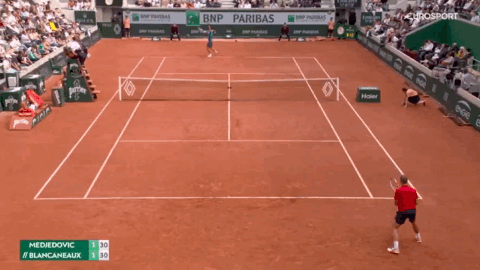
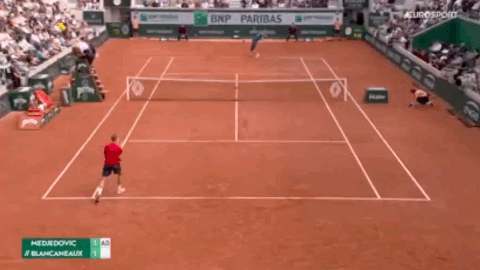
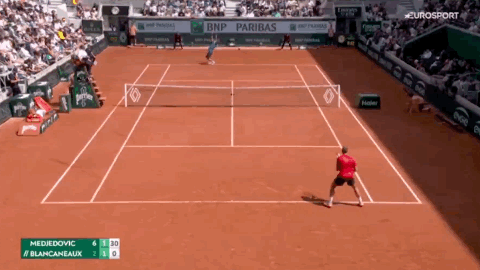
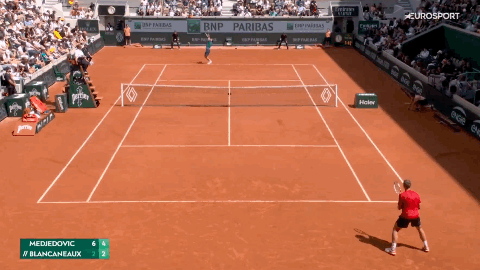
Hamad Medjedovic's points to 1-1* 15-40, 1st set (top left), to break 2-1, 1st set (top right), to 1-1* 0-40, 2nd set (top right), and to 4-2* 0-15 (bottom right) (📸 Eurosport GB)
After being back from illness, H. Medjedovic re-started his season with a bang, most notably taking a set off Daniil Medvedev despite the loss at 6-7(5), 6-2, 5-7 as a qualifier after defeating Alejandro Davidovich Fokina, all in the first two rounds of Rome Masters 1000. Here, he stunned Lucas Pouille 6-3, 7-5 in a high-quality battle during the first qualifying round, compared to G. Blancaneaux, who also qualified last year, had a poor clay season with the early exits even after winning the New Delhi Challenger on the hard courts, but he managed to score a Top 150 win in Duje Ajdukovic, 7-5, 6-4, in the second qualifying round. This match would test their offensives, where one who appeared more aggressive could prevail.
Even though H. Medjedovic had to survive a nervy start as he faced a break point earlier in the first game due to his forehand error, but he still managed to hold his serves to 1-0 in the first set. G. Blancaneaux might have started the third game with a forehand error, but the 2023 NextGen Finals champion scored his earliest break point of the game through a drop shot before converting it via a forehand winner (3-1). The former turned out to double the break thanks to his fourth-shot forehand winner, taking the first set 6-2 through an unreturned serve as he survived the tendency to rush his third-shot forehands midway. He continued the dominance in the second set as he fired a backhand down-the-line winner to create his break point in the third game before eventually breaking to 2-1. Almost replicating the previous set, his cross-court backhand winner preceded another forehand winner for the first two points of the seventh game, dominating his way to break again 5-2 before finally getting the straight-set victory (6-2), concluding the match in a confident showing compared to his qualification last year.
Section 14: Valentin Vacherot [14] def. Billy Harris 7-6(2), 7-5




Valentin Vacherot's point to *2-2 30-30 (1st set) (top left), to 6-6(2-1, 1st set tie-breaker) (top right), to break 4-3 in the 2nd set (bottom left), and to hold 4-4 in the 2nd set (bottom right) (📸 Eurosport GB)
Vacherot could not stop rolling since winning the Nonthaburi 1-2 and Pune Challengers, kept rising until he also became a semifinalist in the Aix-en-Provence Challenger as eventual champion Alejandro Tabilo defeated him in 3 sets. In the Roland Garros qualifying rounds itself, Vacherot defeated Gabriel Debru and Enzo Couacaud in identical scorelines (4-6, 6-3, 7-5), including a comeback win from 4-6, 0-2 in the latter match before facing Billy Harris, who adapted well on clay as he notably tussled with Bernabe Zapata Miralles in the quarterfinals of the Barcelona Challenger despite the 5-7, 6-7(2) loss as well as taking a set off Hugo Dellien of all people in the Rome (Italy) Challenger quarterfinals before stunning 17th seed Emilio Nava 6-3, 4-6, 6-1, followed by fighting his way to defeat wild card Manuel Guinard 6-3, 3-6, 7-6(4) in the second qualifying round. This could be a tough ordeal for B. Harris, considering Vacherot’s form and offensives, but nothing is impossible until the match is called.
This match once again turned out to be another classic Vacherot rollercoaster (in Roland Garros qualifying terms). Starting the match by almost breaking early due to B. Harris’ +1 forehand error before the Brit held to 2-2 in the first set, Vacherot overcame another deficit through a notable backhand down-the-line winner in the fifth game only to get broken in the seventh game due to his forehand errors (4-3). As B. Harris should have served for the first set in the tenth game, the Monegasque 14th seed broke back to 5-5 thanks to his constant redirections as he got even more comfortable with his angles, asking further shot placement questions to B. Harris. Sealing the first set after nailing the tie-breaker 7-6(2), not looking back as he led 2-1 in the breaker thanks to his backhand winner, Vacherot somehow got broken early again to 2-0 for the same reason with the first set (forehand). However, Vacherot bounced back, regaining his accurate forehands in time with a winner to break it (4-3). Volleying his way to strengthen his position (4-4), Vacherot earned the crucial break in the eleventh game (6-5) as his forehand down-the-line winner paved the way, successfully serving it out (7-5) to keep on rolling in this season.
Section 11: Giulio Zeppieri [31] def. Otto Virtanen 6-2, 6-2
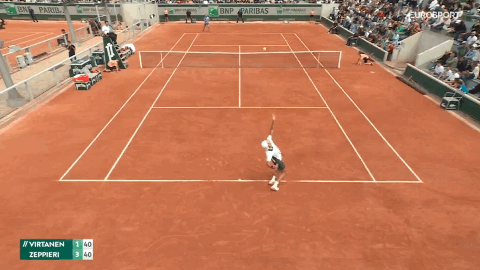
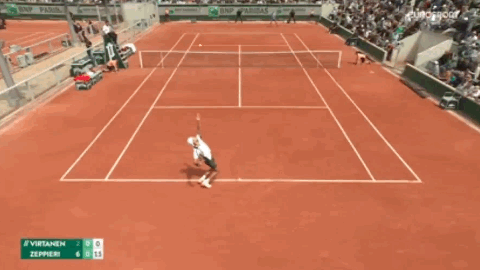
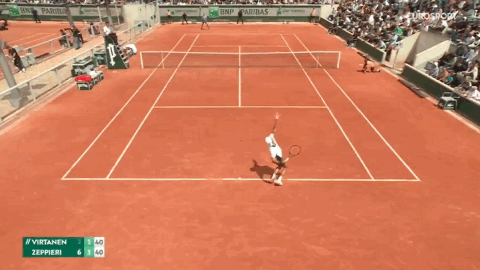
Giulio Zeppieri's point to 3-1* 40-ad (latest break point, 1st set) (top left), to *0-0 0-30 in the 2nd set (top right), and to 3-1* 40-ad in the 2nd set (bottom) (📸 Eurosport GB)
Despite having a subpar clay season and an underwhelming first part of the Asian Challenger swing on the hard courts beforehand, most of which was a result of his unserious mode coming out, except in some occasions where he was competitive enough despite the loss (e.g. in the second round of the Mauthausen Challenger against Max Hans Rehberg and the first qualifying round of the Turin Challenger against Marc-Andrea Huesler), O. Virtanen became even more serious during the Roland Garros qualification rounds, having a solid showing against Dane Sweeny 6-2, 6-3 and stunning the 11th seed Dominic Thiem 6-3, 7-5 in the Austrian's last-ever Roland Garros match. He faced a decent test in 31st seed Giulio Zeppieri, who, despite also his competitive early eliminations in most Challenger events he partook (most notably got defeated by Fabio Fognini 6-2, 6-3 in the first round of the Turin Challenger as a qualifier), he managed to regain his clay-court form in time as he defeated his fellow Italian Stefano Travaglia 6-3, 6-2 and survived trouble as he defeated Adrian Andreev 4-6, 7-5, 6-3 in another close encounter. Knowing both players, this should be one of those days where the more aggressive one would prevail in this match, but only those who could stay consistent in their range.
O. Virtanen started the match unseriously as his forehand errors resulted in G. Zeppieri breaking early to 1-0. Somehow, even with the Finn’s best efforts to save the break points, G. Zeppieri’s smash secured his latest break point before he doubled the break to 4-1, and he did not look back as he took the first set 6-2. Almost similarly, the Italian 31st seed started the second set with an early break due to O. Virtanen’s erratic showing, but the former had a forehand pass to O. Virtanen’s position at the net to generate his second break point before doubling the break in the same spot with the first set (fifth game). Consolidating his position with a service game hold (5-1), G. Zeppieri affirmed his dominance by also taking the second set 6-2, doing what he had to do to secure his spot in the main draw, just like when he became the first to qualify in the Australian Open this year.
Section 12: Gustavo Heide def. Matteo Gigante [28] 6-3, 6-2

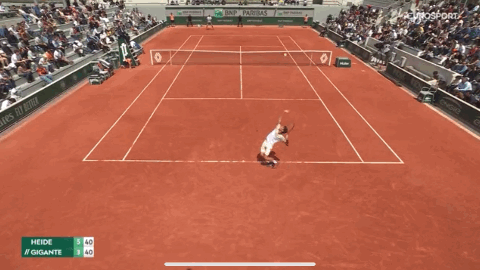

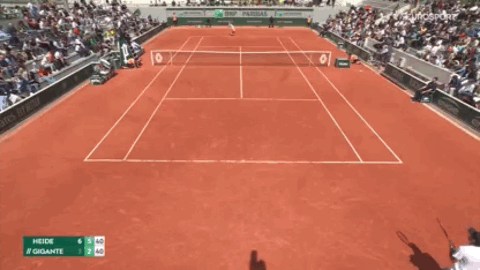
Gustavo Heide's points to 1-1* 40-40, 1st set (top left), to 5-2* 40-ad (set point-setting, 1st set, top right), to 5-2* 40-40, 2nd set (bottom left), and to 5-2* 40-ad, 2nd set (bottom right) (📸 Eurosport GB)
Trying to show the potential he has, M. Gigante came to this clay season prepared despite several rollercoasters, one of which was the Napoli Challenger quarterfinal against Luca Nardi, which he lost 6-4, 4-6, 1-6 while surviving the Marrakech qualification rounds as he defeated both Karim Bennani and Rudolf Molleker in 3 sets before having to retire down 3-6, 0-2 against Roberto Carballes Baena in the first round. This was also the case in this year's Roland Garros qualification rounds, as he had to survive two three-set matches against wild card Sacha Gueymard Wayenburg (6-4, 5-7, 6-4) and Dalibor Svrcina (4-6, 6-3, 7-5), coming back from a break down against the latter. In contrast, G. Heide came from his maiden Challenger title in Asuncion (d. Joao Fonseca 7-5, 6-7(6), 6-1) despite exiting in the second round in all his European clay campaigns (Mauthausen & Oeiras 4 Challengers), somehow navigating his way through the Roland Garros qualifying rounds after pulling a whole comeback against 12th seed Lukas Klein 1-6, 6-3, 7-6(5) and Bu Yunchaokete 7-5, 6-3 in a more convincing manner. This match could be a classic, decent test that showcased the best in them, with the more balanced player standing out in this match.
G. Heide commenced the match by breaking early to 2-1 as he outhit M. Gigante’s forehands while firing a working volley to secure the first deuce before the said break. He consolidated his lead to 3-1 and turned out to break for the first set (6-3) several games later after a backhand error fumbled M. Gigante’s break point, followed by his frequent forehand errors. Several games in, both players turned out to tussle for in total of 24 minutes including the first two games right after the Italian 29th seed forced the first deuce. By the conclusion of the third game, G. Heide had a massive hold to 2-1, which turned out to be crucial as he broke to 4-2 after a 0-hold due to M. Gigante’s frequent backhand errors and double faults (at least twice of the latter’s mistakes along the way). Without looking back, G. Heide strengthened his position with a service game hold to 5-2, constructing his break point through his preceding backhands after forcing a deuce through a backhand winner before taking the second set 6-2 due to M. Gigante’s forehand error, securing his maiden Grand Slam main draw appearance as he continued to rise this season.
Section 3: Mattia Bellucci def. Alejandro Moro Canas 3-6, 6-2, 7-6(7)
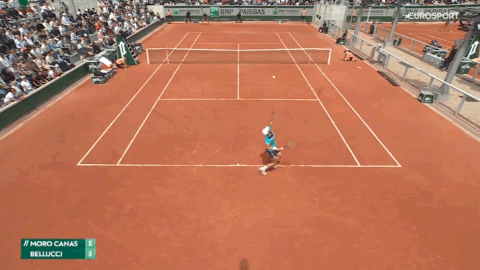
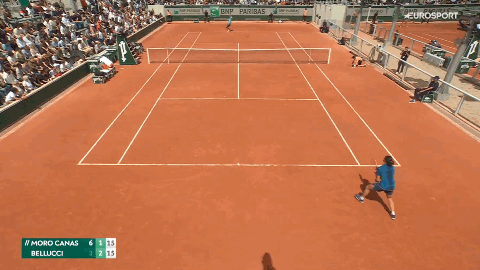
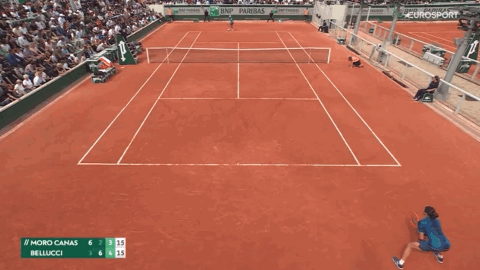
Mattia Bellucci's point to 5-3* 0-15, 1st set (top left), to *1-2 15-30, 2nd set (top right), and to *3-4 15-30, 3rd set (bottom) (📸 Eurosport GB)
A. Moro Canas came to the Roland Garros qualifying rounds completely in form, which started from his second-round loss against Taylor Fritz 6-3, 6-1 after stunning Dominic Thiem 6-4, 6-4 in the first round for his first-level ATP-level victory. Building up from there, he went on to win his maiden Challenger title in Rome (Italy), defeating his fellow first-time finalist Vilius Gaubas 7-5, 6-3 after denying the Lithuanian youngster the chance to serve for the first set, continuing this with a confident showing in the first two qualifying rounds as he defeated Marc Polmans 6-1, 6-2 and wild card Maxime Janvier 6-3, 6-4 to set a clash against Mattia Bellucci. In contrast, the Italian had an interesting approach, reaching the quarterfinals in the hard courts of the Shenzhen (Luohu) Challenger (l. James Duckworth) for his best showing in the first part of the Asian Challenger swing before returning to Europe, starting his clay season in the Turin Challenger qualifying rounds as he defeated Alexis Galarneau 6-7(3), 6-3, 6-2 after a scrappy start only to be defeated by an in-form Francesco Maestrelli 6-3, 6-2 in the first round. He followed this up by defeating Matteo Martineau 3-6, 6-1, 6-1 and stunning 20th seed Lloyd Harris 6-1, 7-6(9) after recovering from a 1-4 deficit in the tie-breaker and surviving a set point, setting this encounter that could come down to their pressure points’ handling despite their fiery groundstrokes at their best. Indeed, the match did not disappoint, it had everything.
As A. Moro Canas dominated the first set through his powerful aggression, taking the first set 6-3 while surviving the Italian’s backhand pass in hopes of prolonging the said set, M. Bellucci steadily struck back from the baseline, which pressed A. Moro Canas’ second serves enough for the Spaniard to commit a double fault to be broken (1-3). M. Bellucci then consolidated his lead to 4-1 and ended up going after A. Moro Canas’ forehands, which assisted him in breaking for the second set 6-2. The deciding set turned out to play a big role as both players upped their aggression against each other and struck the ball as cleanly as possible, as well as displaying their stellar point constructions in between. This included M. Bellucci’s notable drop shot for a one-point lead even if it was neutralized through a backhand pass, where the Italian held his service game to 4-3 even if he had to survive a break point back in the sixth game. With A. Moro Canas holding his service games to 6-6, a match tie-break occurred to determine the rest of the match, where the former was unable to capitalize on his 4-2 lead (which happened due to M. Bellucci’s double-fault right at the first point of the breaker), followed by a volley error. Subsequently, A. Moro Canas’ forehand error, which was fired too long, generated M. Bellucci’s mini-break to 6-5, and even though he had a match point saved earlier, an unreturned serve converted the match point as M. Bellucci took the third set 7-6(7), thus securing his spot in the main draw.
Section 10: Gregoire Barrere [10] def. Denis Kudla 3-6, 6-2, 6-3
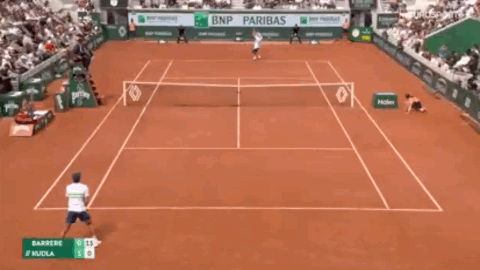
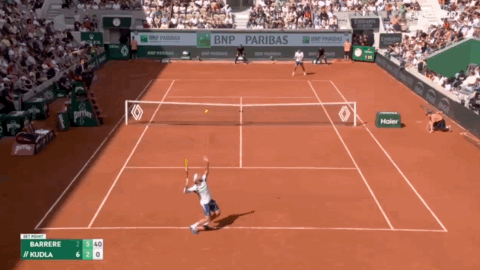
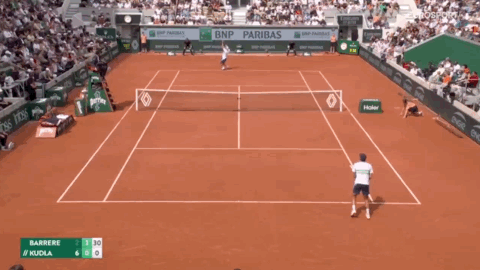
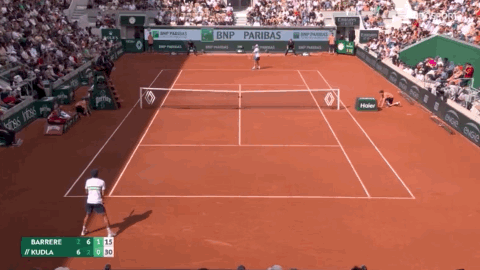
Gregoire Barrere's points to 0-1* 0-30, 1st set (top left), 1-0* 0-40, 2nd set (top right), to take the 2nd set 6-2 (bottom left), and to 1-0* 30-30, 3rd set (bottom right) (📸 Eurosport GB)
G. Barrere might have had a slow start to the season back on the hard courts, but the clay season turned out to be a perfect moment for him to bounce back from these setbacks. Most notably, he reached the semifinals of Bucharest (250) (l. Mariano Navone) and Aix-en-Provence Challenger (l. Arthur Fils), defeating wild card Theo Papamalamis 6-3, 6-1 and Andrea Pellegrino 6-2, 3-6, 6-4 coming to the Roland Garros third qualifying round. On the other hand, outside of the San Luis Potosi Challenger semifinal, it was a subpar clay-court campaign for Denis Kudla before suddenly goating in the French Open qualifying rounds, as he defeated other clay-court frequents Jan Choinski 6-4, 6-4, and 19th seed Vit Kopriva 3-6, 6-3, 6-3 in the first two qualifying rounds. As the more aggressive one from the said two players took this, this ended up testing their range consistency when the match allowed, especially with such pacing.
Even though this match started with D. Kudla suddenly peaking through his passes, G. Barrere had a notable backhand down-the-line winner to win the second point of the second game (in the first set) in hopes of breaking back, but to no avail even if he had several break points as D. Kudla held his serves to 2-0, and turned out to dominate the flow as he doubled the break and took the first set 6-2. However, G. Barrere regrouped after he held the first game of the second game, creating his break point with a volley before he broke to 2-0. Even if he got broken back right after as D. Kudla leveled the play (2-1), G. Barrere went after D. Kudla’s forehands to break again to 4-2, topped by the American’s double-fault. By then, G. Barrere broke again for the second set thanks to his backhand to D. Kudla’s slice error as he targeted D. Kudla’s forehands midway. The French 10th seed then emphasized the importance of his setup as his preceding backhand equalized the play in the fourth point of the second game (1-0* to 30-30) before D. Kudla’s two consecutive double faults secured the former’s break of serve (2-0). Since then, G. Barrere did not look back, strengthening his lead to 3-0 while almost demolishing D. Kudla as he forced the deuce in the fourth game. Ultimately, even if D. Kudla held his service games, it was insufficient to put more pressure on G. Barrere as the Frenchman took the 3rd set 6-3, confirming his resurgence with a main draw spot in his home Slam.
Section 9: Gabriel Diallo def. Alexander Ritschard 3-6, 6-2, 6-3




Gabriel Diallo's point to 2-1* 40-ad (earlier break point, 2nd set, top left), to 5-2* 0-40 in the 2nd set (top right), to 1-2* 30-40 (3rd break point, 3rd set, bottom left), and 3-2* 30-40 (1st break point, 3rd set, bottom right) (📸 Eurosport GB)
This clash might have been overlooked on paper as several other names were favored instead, but they proved that nothing is impossible. Gabriel Diallo built his rally tolerance a long way despite his loss to Mitchell Krueger in 2 tie-break sets back in Houston (250), fighting his way despite his elimination to eventual champion Thanasi Kokkinakis 6-7(3), 6-4, 6-7(3) in a 3-hour-30-minute battle, and displaying it as well in the first round of the Mauthausen Challenger before he had to retire down 6-3, 5-7, 2-4 against Lukas Neumayer. Interestingly, as he also defeated some clay-court frequents along the way, which included Orlando Luz and Hugo Dellien in the Turin Challenger qualifying rounds, he also dug deep to defeat Argentineans Genaro Alberto Olivieri 7-5, 6-7(4), 6-1 and Marco Trungelliti 7-6(6), 3-6, 6-4 in the first two qualifying rounds in Roland Garros. On the other hand, A. Ritschard had an intriguing United States clay campaign, as he qualified for the Houston (250) before being defeated by J.J. Wolf in the first round and went on to win the Savannah Challenger after defeating qualifier Andres Andrade 6-2, 6-4 for the first time since the Hamburg Challenger 2022, going straight to the Roland Garros qualifying rounds by confidently stunning the Oeiras 4 Challenger runner-up, Elias Ymer, 6-2, 6-1, and Titouan Droguet 6-1, 6-3 in the first two qualifying rounds. For either player, this could be all to play for, showcasing everything they got in terms of their point construction and some balanced plays for a spot in the main draw.
In the first set, G. Diallo struggled with forehand errors, allowing A. Ritschard to break early (1-0) and take a 2-0 lead. The same forehand error resulted in A. Ritschard’s double-break lead, where he eventually took the first set 6-2. Nonetheless, the Canadian started to hit the ball even harder, smashing it to generate his third break point before finally breaking to 3-1 due to A. Ritschard’s forehand error, and held his service game afterward to 4-1. Ultimately, G. Diallo forced the deciding set as he broke to 6-2, getting broken early moments after he double-faulted in the fourth game of the first game to start the third set. The Canadian returned from the brink by becoming more offensive, breaking back to 2-2 before doing it again to 4-2 as his forehand winner generated his first break point, eventually taking the 5-2 lead. Two games later, after overcoming a couple of deficits, G. Diallo served for the match (6-3) and secured his first appearance in a Grand Slam-level main draw. This win showcased improvements in his rally tolerance and pacing on red clay. Interestingly, the final scoreline coincidentally matched that of a previous match in Section 10.
#atp world tour#atp tour#grand slam#french open#roland garros#roland garros 2024#tennis updates#hot shots#break point#hamad medjedovic#geoffrey blancaneaux#shintaro mochizuki#facundo bagnis#valentin vacherot#billy harris#giulio zeppieri#otto virtanen#gustavo heide#matteo gigante#mattia bellucci#alejandro moro canas#gregoire barrere#denis kudla#gabriel diallo#alexander ritschard#know your qualifiers
0 notes
Video
youtube
Alejandro Tabilo vs Giulio Zeppieri | F Karlsruhe • Highlights
#youtube#Che sfortuna Giulio! Dopo un primo set dominato una brutta caduta lo mette ko. tabilo zeppieri karlsruhe tennishighlights atpchallenger
0 notes
Text
Lazio: approvata legge sul caregiver familiare

Lazio: approvata legge sul caregiver familiare
Il Consiglio regionale del Lazio ha approvato oggi all'unanimità dei presenti la proposta di legge regionale n. 132 del 9 febbraio 2024, concernente "Disposizioni per il riconoscimento e il sostegno del caregiver familiare".
In precedenza, aveva ricevuto il voto favorevole dell'Aula anche la proposta di deliberazione consiliare n. 11 del 4 ottobre 2023, concernente "Approvazione del 'Piano d'azione per le zone vulnerabili all'inquinamento da nitrati di origine agricola della Regione Lazio'. Direttiva 91/676/CE – D.Lgs. 152/2006 – DM 5046/2016". In apertura di seduta, vi era stato il ricordo da parte del presidente Antonello Aurigemma della consigliera Valentina Paterna, recentemente scomparsa, con l'annuncio del conseguente ingresso in Consiglio di Giulio Menegali Zeli Iacobuzi.
Una proposta di legge, quella sul caregiver, che è stata "oggetto di un egregio lavoro in commissione", come ha detto l'assessore ai Servizi sociali Massimiliano Maselli nella sua relazione; una proposta incentrata sulla figura del caregiver familiare come componente della rete di assistenza alla persona ma anche come portatore di diritti propri, distinti da quelli della persona da lui assistita, recita l'articolo 1 della normativa. Normativa "attesa da tutto il mondo che ruota intorno alla disabilità", così ancora l'assessore. Pochi articoli, scritti in modo semplice, in modo da renderla accessibile a tutti, questo il modo in cui è stata scritta questa normativa, secondo Maselli, che ha ricordato le novità più rilevanti che essa introduce, dal ruolo attivo che essa conferisce al caregiver per la prima volta, alla "giornata del caregiver" in essa prevista all'articolo 11, fino al riconoscimento, dal momento che almeno il 7 per cento dei caregiver è in una fascia di età giovanile, di crediti formativi a fini di studio, che è previsto nell'articolo 10. 15 milioni di euro nel triennio 2024-26 sono gli stanziamenti previsti per questa legge dalla norma finanziaria, l'articolo 14.
Numerosi gli emendamenti ai vari articoli approvati, provenienti sia dalla maggioranza con Maria Chiara Iannarelli di Fratelli d'Italia, che dall'opposizione con Marta Bonafoni del Partito democratico, Alessandra Zeppieri del Polo progressista, e alcuni dallo stesso assessore Maselli, che in altri casi ha provveduto alla riformulazione di alcuni, in modo da poter dare ad essi parere positivo.
Il riconoscimento di una figura che c'è sempre stata ma non lo ha mai ottenuto ufficialmente, questo è lo scopo della legge secondo la presidente della commissione Sanità Alessia Savo, che ha ricordato come 25 mila persone nella nostra regione svolgano questa attività. Apprezzamento per la proposta è venuto anche dall'opposizione, con la consigliera Marietta Tidei di Italia viva. "Un lavoro fatto insieme" è stato quello che si è realizzato su questa proposta, anche per il consigliere Rodolfo Lena del Pd. Apprezzamento anche da Marta Bonafoni, secondo la quale anche il governo nazionale dovrebbe trarre ispirazione da questo lavoro fatto nel Lazio in modo condiviso. "Un percorso importante" apre questa normativa, secondo Alessandra Zeppieri. Con riferimento all'accenno di Bonafoni, Maselli ha detto in una breve replica che gli risulta si stia lavorando anche a livello nazionale sul tema. Importante la continuità del lavoro su questi temi, ha detto in conclusione l'assessore. Il voto favorevole dei vari gruppi di maggioranza è stato poi annunciato, in sede di dichiarazione di voto, da Nazareno Neri di Noi moderati, Luciano Crea della lista Rocca e Daniele Sabatini di Fratelli d'Italia; tutti hanno ringraziato la Giunta per il lavoro fatto su questa normativa di grande "concretezza", come ha detto Sabatini.
"Procedura obbligata", invece, era stata definita dall'assessore al Bilancio Giancarlo Righini nella sua illustrazione del provvedimento, quella che viene avviata con la proposta di deliberazione consiliare approvata prima della proposta di legge, vista la procedura di infrazione europea pendente in materia. Il Piano d'azione fissa i criteri e le norme tecniche generali per l'utilizzazione agronomica dei materiali e delle sostanze di cui all'articolo 2, al fine di consentire alle sostanze in essi contenute di svolgere un ruolo utile al suolo agricolo. Per Salvatore La Penna del Pd, però, da una procedura per quanto obbligata può nascere una iniziativa su un tema che ha a che fare con la qualità della vita nei nostri territori; d'accordo con queste osservazioni si è detto anche Daniele Maura di Fratelli d'Italia. Righini, da parte sua, ha assicurato che si continuerà a lavorare su questo tema, nel ringraziare per il loro apporto le Direzioni Regionali coinvolte....
#notizie #news #breakingnews #cronaca #politica #eventi #sport #moda
Read the full article
0 notes
Text
Australian Open: avanti Paolini, Zeppieri eliminato da Norrie
Si interrompe al 2° turno il sogno di
Giulio Zeppieri a Melbourne. Ma il ragazzo di Latina ha davvero
sfiorato l’impresa sul campo della 1573 Arena, venendo sconfitto
solo al 5° set e dopo 3 ore e 36′ di lotta dal britannico
Cameron Norrie, testa di serie n.18 del seeding. 3-6, 6-7, 6-2,
6-4, 6-4 i parziali, al termine di un match che ha subito un
paio di interruzioni a causa della…
View On WordPress
0 notes
Text
Alejandro Tabilo se coronó campeón del Challenger de Karlsruhe
Nueva publicación en https://ct2.cl/7C
Alejandro Tabilo se coronó campeón del Challenger de Karlsruhe
El chileno 145 del mundo resultó triunfador tras un desafortunado final.
Foto: Team Chile
En tan solo 2 sets, el tenista nacional Alejandro Tabilo, 145 del mundo, se quedó con el primer lugar del Challenger de Karlsruhe en Alemania, luego de que su oponente, el tenista italiano Giulio Zeppieri, 125 del mundo, se retirara por una lesión.
Zeppieri después de ganar el primer set 6-2, debió abandonar el encuentro después de una caída al inicio del segundo set.
0 notes
Text
Tweeted
RT @WeAreTennisITA: ARNALDI NEL CLUB DEI 💯 L'ottimo #MMOpen disputato da Arnaldi gli vale l'ingresso in top 100 ATP, insieme ad altri 5 azzurri 🇮🇹 8️⃣ Sinner 1️⃣9️⃣ Musetti 2️⃣0️⃣ Berrettini 4️⃣8️⃣ Sonego 8️⃣3️⃣ Cecchinato 9️⃣8️⃣ Arnaldi Sale anche Giulio Zeppieri, ora 120 ATP 👏 https://t.co/aMJv6SDsZI
— Mario Calandra (@MariusKalander) May 8, 2023
0 notes
Text
Giulio Zeppieri
Giulio Zeppieri is an Italian tennis player. He attained the title of Challenger in Barletta to defeat compatriot Flavio Cobolli in August 2021. You may get here Giulio Zeppieri's tennis career, wife, net worth, salary, height, family, and more

#Giulio Zeppieri#Giulio Zeppieri wife#Giulio Zeppieri net worth#Giulio Zeppieri family#Giulio Zeppieri salary#Giulio Zeppieri height
0 notes
Text
non so se è merito del sole croato o del fatto che sta giocando da dio contro carlitos, ma in questo momento zeppieri mi sembra davvero davvero gnocco
0 notes
Photo

Pioneer
Ricardo Morandi (Rome, 1902-1989)
Morandi was an Italian civil engineer best known for his interesting use of reinforced concrete. Unfortunately, today 14th, August, one of his most known infrastructures, the Morandi Bridge in Genoa, collapsed. Terrible news.
It’s time to remember and seriouly think about what happens when we find a lack of maintainance on infrastructures and buildings.. hard work we have to advice our clients and neighboors the importance of maintenance of our homes and on a large scale, our cities.
You must know the hole legacy of Morandi’s works as engineer :
Opere e progetti
1931 - Villino in viale Vaticano, Roma
1932 - Cinematografo Odescalchi, (poi Majestic), Roma (con V. Marchi)
1932 - Autorimessa Piccini, via delle Fornaci, Roma
1934 - Chiesa di Santa Barbara, Colleferro
1933/34 - Cinema Augustus, Corso Vittorio, Roma (con A. Lombardini)
1935 - Cementificio a Colleferro, Roma
1935/39 - Cinema-teatro Giulio Cesare con soprastante edificio, viale Giulio Cesare, Roma
1938 - Cinema-Teatro Quattro Fontane, in via Quattro Fontane, Roma (intervento di restauro)
1941/49 - Palazzina in via delle Terme Daciane, Roma
1945 - Ponte San Giorgio sul fiume Liri, Frosinone
1946 - Cinematografo Astoria in via Stoppani, Roma
1947 - Cinematografo Alcyone, via Lago di Lesina, Roma (con G. Gandolfi)
1947/48 - Cinematografo Bologna, via Stamira a Roma
1948 - Centrale termoelettrica S.R.E. a San Paolo, Roma
1949 - Ponte a travata sull'Elsa, Canneto
1949/50 - Ponte detto del “Grillo” sul Tevere, Roma
1950 - Palazzina in via Martelli, Roma
1950 - Auditorium dell'Accademia Musicale di Santa Cecilia, Via Flaminia, Roma (con C. Carrara, P. Baruffi, progetto);
1950/54 - Stabilimento per la produzione delle fibre sintetiche al Castellaccio, presso Anagni, Frosinone
1950/51 - Fabbrica di fiammiferi a Zaule, Trieste
1951/52 - Centrale termoelettrica a Civitavecchia, Roma (con l'Ufficio Tecnico dell'Impresa Mantelli di Genova,)
1952 - Ponte di Giunture sul Liri, Sant'Apollinare, Frosinone
1952 - Ponte sull'Arno tra Empoli e Spicchio di Vinci, inaugurato nel 1954
1952/54 - Ponte Morandi, passerella pedonale sul torrente Lussia nella valle dell'Edron, a Vagli di Sotto in Alta Garfagnana, Lucca
1953 - Ponte sul Liri a Sora, Frosinone
1953 - Autorimessa a Firenze
1953/55 - Rafforzamento statico di un'ala dell'arena di Verona
1953/54 - Ponte sullo Storms River, Elizabethville, Sudafrica
1953/55 - Cementificio a Scafa San Valentino, Pescara
1954 - Ponte “Gornalunga”, Enna
1954 - Ponte sul Cerami, Galliano Castelferrato, Enna
1954 - Centrale termoelettrica S.R.E. (Società Romana Elettricità), Fiumicino, Roma
1954/56 - Ponte Amerigo Vespucci sul fiume Arno, Firenze (con G. e P. Gori, F. Nerli)
1954/57 - Cinema teatro Maestoso con soprastante edificio per abitazioni, via Appia Nuova, Roma
1954/58 - Centrale termoelettrica Santa Barbara, Cavriglia, Arezzo
1955/57 - Centro studi e stabilimenti Bombrini,Parodi-Delfino a Colleferro, Roma
1956/57 - Mercato coperto “Metronio”, via Magna Grecia, Roma
1957 - Cementificio Calci e Cementi a Savignano sul Panaro, Modena
1957 - Ponte sul canale navigabile di Fiumicino sulla strada Ostia- Fiumicino, Roma
1957 - Ponte sul Sambro per l'Autostrada Firenze-Bologna
1957 - Ponte “General Rafael Urdaneta” sulla laguna di Maracaibo, Venezuela
1957 - Viadotto sul Setta presso “La Quercia”, Bologna, per l'Autostrada Firenze-Bologna
1957/60 - Terminal dell'Aeroporto Internazionale Leonardo da Vinci, Fiumicino, Roma (con A. Luccichenti, V. Monaco, A. Zavitteri, realizzato)
1957/62 - Centrale elettronucleare Garigliano, Minturno, Latina
1958/59 - Quinto padiglione della Torino Esposizioni al Parco del Valentino, Torino
1958/60 - Cavalcavia della via Olimpica su Corso di Francia, Roma
1958/61 - Viadotto sul Fiumarella, Catanzaro
1959 - Palazzo del lavoro, Torino (con G. Gambetti, A. Origlia D'Isola, progetto)
1959/60 - Salone dell'Automobile, Torino
1959/62 - Palazzo degli Uffici Comunali di Carrara
1959/64 - Centrale termoelettrica Selt Valdarno, Marzotto, Livorno
1960 - Ponte sul Columbia River, Canada (con Choukalos, Woodburn e Mckenzie Ldt)
1960/61 - Sollevamento dei templi egizi di Abu Simbel nell'Alto Egitto (con G. Colonnetti, P. Gazzola, progetto)
1960/62 - Ponte “G. Capograssi”, Sulmona, L'Aquila,
1960/64 - Viadotto sul torrente Polcevera e sul parco ferroviario a Genova, autostrada Genova-Savona
1960/65 - Centrale termoelettrica “Marzocco”, Livorno
1961 - Aviorimessa DC8 e officine Alitalia nell'Aeroporto Leonardo da Vinci a Fiumicino, Roma (con A. Luccichenti, V. Monaco, A. Zavitteri)
1961 - Monorotaia Alweg per l'Esposizione Italia ‘61 a Torino
1961/62 - Centrale termoelettrica Torre Valdaliga, Civitavecchia, Roma (con M. Magistrelli)
1962 - Ponte a Göteborg, Svezia
1962/63 - Cementificio Calci e Cementi di Segni a Colleferro, Roma
1962/64 - Ponte sul Lago di Paola, Sabaudia, Latina
1963/67 - Albergo-ristorante “Alfonso al Faro”, a San Felice Circeo, Latina (con E. Moretti)
1963/67 - Viadotto sull'ansa del Tevere nel tratto di Autostrada Roma-Aeroporto di Fiumicino presso la Magliana, Roma,
1964 - Autorimessa Zeppieri a Frosinone
1964/67 - Centrale termoelettrica detta del Bastardo, Foligno, Perugia
1964/68 - Ponti sul rio Guayas presso Guayaquil, Ecuador
1965/66 - Viadotto sul Favazzina presso Scilla, Reggio Calabria, per l'autostrada Salerno-Reggio Calabria
Viadotto di Wadi el Kuf presso Beida, Libia
1965/71 - Ponte sul Wadi al-Kuf presso Beida, Libia (con A. Rinelli, A. U. Manella, O. Scrosky)
1965/74 - Consolidamento della Torre pendente di Pisa (progetto)
1966 - Villa a Salto di Fondi, Latina (con Elena Moretti)
1966/67 - Vasche navali in via Vallerano, Roma
1966/68 - Viadotto Scirò per l'Autostrada Salerno-Reggio Calabria
1967/70 - Studi per l'asse attrezzato a Roma (con V. Delleani, M. Fiorentino, F. e L. Passarelli, L. Quaroni, B. Zevi, - Studio Asse - progetto)
1967 - Viadotto sul Lontrano dell'Autostrada Salerno-Reggio Calabria
1968 - Ponte sul Salso a Licata, Agrigento
1969/73 - Centro Commerciale “La Piramide” ad Abidjan, Costa d'Avorio (con R. Olivieri)
1969/70 - Fiumicino, Roma
1969/70 - Centro di manutenzione per aerei Boeing 747 dell'Alitalia nell'Aeroporto Leonardo da Vinci
1969 - Ponte sul Rio Guayas a Guayaquil, Ecuador
1969 - Palazzo dello Sport a Milano (con Prof. Arch. Dagoberto Ortensi, Dott. Ing. Vottorio Mosco, Dott. Ing.Sergio Musmeci, Dott. Ing. Italo Stegher; progetto)
1970 - Viadotto Akragas, vicino alla Valle dei Templi ad Agrigento
1970 - Ponte sul Rio Magdalena a Barranquilla - Colombia
1970/78 - Terminal dell'aeroporto “Fontana Rossa” a Catania
1970/72 - Viadotto sulla Costa Viola presso Scilla sull'autostrada Salerno-Reggio Calabria
1971/1989 - Studi e proposte per il Ponte sullo Stretto di Messina (progetti)
1971 - Studio per un ponte sul Corno D'Oro Istanbul Turchia (progetto)
1971 - Centro elettronico per elaborazione dati dell'Alitalia alla Magliana, Roma
1971 - Ponte a Taranto sul Mar Piccolo
1971/74 - Viadotto Carpineto per la superstrada Basentana presso Vietri, Potenza
1973/76 - Viadotto San Francesco per la strada Garganica, Foggia
1973/77 - Ponte Costanzo sull'Irminio presso Ragusa per la Strada statale 115 Sud Occidentale Sicula (con A. Petruzzi)
1973/78 - Rampe di collegamento fra le autostrade esterne e il porto di Napoli (con L Tocchetti, A. Polese, R. Di Martino)
1975/88 - Hotel Ergife, via Aurelia, Roma (con B.M. Cesarano)
1976/77 - Sede centrale della Società F.A.T.A., Pianezza, Torino (con O. Nyemeyer, M. Gennari)
1977 - Edifici di edilizia economica e popolare a Corviale, Roma (con M. Fiorentino e altri)
1979/80 - Ponte sul vallone Cardinale, Siracusa
1979/80 - Grandi serbatoi idrici in Nigeria
1979/83 - Serbatoio idrico a Valenzano - Bari
1981/84 - Aviorimessa per la manutenzione degli aerei nell'Aeroporto Internazionale Leonardo da Vinci a Fiumicino, Roma (con Studio Trella, L. Nusiner, C. Presenti)
1983 - Ponte di Cortes, Madrid - Spagna
1983/85 - Chiesa di S. Maria Madre del Redentore a Tor Bella Monaca, Roma (con P. Spadolini)
1984 - Viadotto Stronetta per l'Autostrada dei Trafori, tratto Carpugnino-Feriolo, Stresa
1984/89 - Santuario della Madonna delle Lacrime, Siracusa, (con P. Parat, M. Andrult) (da progetto del 1957)
1986/88 - Viadotto Rotaro nei pressi di Lauria, Potenza
1988 - Autorimessa in via delle Vigne Nuove, Roma
1989 - Chiesa nel centro direzionale di Napoli (con P. e G. Spadolini, B. Piscione, R. Sparcio)
+ +
#ricardo morandi#infrastructures#ponte morandi#miguel aguiló#engineering design#precast concrete#caring#cities#arquigraph#renovation#bridges#structural analysis#maintenance
31 notes
·
View notes
Text
Mouilleron-le-Captif Ch QF: Arthur Fery [Q] def. Giulio Zeppieri 7-6(3), 6-2 Match Stats

📸 ATP Challenger Livestream (via website)
Zeppieri had the opportunity to serve for the set and even 3 set points several games later, but it was insufficient to tackle A. Fery’s offensive side, which cost him a lot of moments by then. As a result, A. Fery shifted the moment through the tie-breaker, brought him into some critical unforced errors, and began to hit more cleanly since then to dominate the flow in the second set to get himself out of the chaos, particularly the chaos caused by the first set. As a result, A. Fery had 2 opportunities to break compared to Zeppieri, with having a 56% break point conversion rate strengthened by his second set presence.
On the other hand, A. Fery began to appear more stable in his service games through the second set than the first. While both players had their strengths in the first set, A. Fery’s service game stability led him to be 9% ahead in the first serves winning percentage compared to Zeppieri despite the latter scoring 5 more aces, which emphasized accuracy under pressure as this set went by (despite the aces). As the match went by, Zeppieri’s second set appeared more vulnerable with having 17% lower percentage than A. Fery despite the former double-faulting just once (than A. Fery’s clean service games, especially without the double faults). Quite some contrasts as the dynamics followed.
In what also is his maiden Challenger semifinal appearance, A. Fery will face Antoine Escoffier, who earlier stunned first seed Hugo Gaston 6-1, 6-4. It could be interesting to see what kind of Escoffier popped up in the semifinals, considering he never advanced to the finals before every time he made a Challenger semifinal (until today), which might or might not change depending on A. Fery’s offensive side. This could be another interesting journey to follow, considering A. Fery seemed to spend more of this semester trying the European indoor Challengers.
#atp world tour#atp tour#atp challenger#atp challenger tour#tennis updates#match stats#mouilleron-le-captif challenger#open de vendée#arthur fery#giulio zeppieri#WatchChallengersFolks#ChallengerMatters
0 notes
Text
Alcaraz-Zeppieri, Atp Umago 2022: dove vederla in diretta tv
Alcaraz-Zeppieri, Atp Umago 2022: dove vederla in diretta tv
Grande sfida per il tennista romano che dalle qualificazioni è arrivato in semifinale e sfiderà il giovane campione spagnolo
Uno strepitoso Giulio Zeppieri si è guadagnato il diritto di affrontare oggi, sabato 30 luglio, una grande sfida. Il tennista romano, 20 anni, dalle qualificazioni ha conquistato la semifinale dell’Atp 2022 di Umago.
…Read MoreTennisToday

View On WordPress
0 notes
Video
youtube
Giulio Zeppieri vs Benoit Paire | R2 Karlsruhe • Highlights
0 notes
Text
Australian Open: Sonego battuto dal n.2 del mondo Alcaraz
Anche Lorenzo Sonego esce di scena agli Australian Open dopo il ko nella notte di Zeppieri. L’azzurro lotta e tiene tre ore e mezza in campo Carlos Alcaraz (n°2 del mondo), che si impone 6-4, 6-7, 6-3, 7-6 e vola al 3° turno degli Australian Open.
Avanti Paolini, Zeppieri eliminato da Norrie
Si interrompe al 2° turno il sogno di Giulio Zeppieri a Melbourne. Ma il ragazzo di Latina ha…
View On WordPress
0 notes
